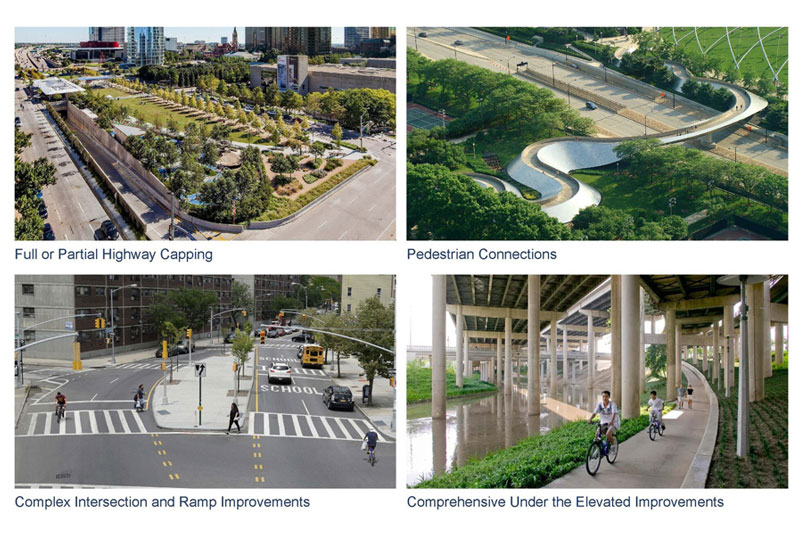
Examples of treatments that could be applied to BQE North and South. Credit: Department of Transportation
By MOHAMED FARGHALY
The U.S. Department of Transportation has greenlit a $5.6 million grant to propel forward a transformative redesign of the Brooklyn-Queens Expressway’s (BQE) North and South corridors, Brooklyn elected officials revealed. For nearly seven decades, the BQE, colloquially referred to as the “trench,” has severed neighborhoods like South Williamsburg and Sunset Park, fostering environmental hazards and health concerns due to noise, pollution, and heightened levels of respiratory illnesses.
This substantial grant, announced on March 12, aims to mend these urban scars, fostering community cohesion while mitigating the adverse environmental and economic impacts stemming from the daily influx of approximately 150,000 vehicles along the expressway.
Brooklyn representatives, alongside the Brooklyn-Queens Expressway Environmental Justice Coalition, a consortium comprising 17 community groups spanning northern to southern Brooklyn, have waged a sustained campaign to rectify the infrastructural rifts caused by the BQE’s inception, led by the influential urban planner Robert Moses. In a unified statement on the 12th, Democratic Leader Hakeem Jeffries (NY-08), Rep. Dan Goldman (NY-10), Rep. Nydia Velázquez (NY-07), U.S. Sen. Charles Schumer, and U.S. Sen. Kirsten Gillibrand lauded the decision, highlighting their concerted efforts to prioritize the “BQE Connects: Advancing the BQE North and South Corridor Vision” grant.
“This grant is the catalyst we need to finally put together a comprehensive plan to reimagine the entire BQE corridor and to address environmental justice issues that plague the northern and southern portions of the expressway,” the officials stated. “Our offices will work to ensure this is just the beginning of the federal government’s investment in the BQE with fairness and justice at the forefront.”
Echoing this sentiment, the Brooklyn-Queens Expressway Environmental Justice Coalition emphasized a clear vision to reshape the BQE into a space prioritizing the well-being of all affected communities, pledging to advocate for environmentally conscious decision-making in future infrastructure planning. Notably, the grant’s approval follows Mayor Eric Adams’ announcement, heralding a significant step toward rectifying the historical disunity sewed by the BQE’s construction.
Governor Kathy Hochul and state DOT Commissioner Marie Therese Dominguez reaffirmed their dedication to collaborative efforts with the community and governmental stakeholders in this endeavor. Deputy Mayor for Operations Meera Joshi lauded the city’s Federal Infrastructure Task Force for crafting exemplary grant applications, which also secured a $117 million federal grant to advance the QueensWay project, a park initiative situated on a disused corridor of the former LIRR Rockaway Beach Branch. However, a contentious $800 million NYC DOT grant proposal aimed at rebuilding the deteriorating BQE Central section, stretching from Atlantic Avenue to Sands Street, was recently rebuffed. NYC DOT Commissioner Ydanis Rodriguez expressed eagerness to explore various initiatives in consultation with Brooklyn residents along the BQE, envisioning possibilities like highway capping, street redesigns, and other enhancements to the corridor.
Notably, NYC DOT has orchestrated workshops to solicit ideas for enhancing areas adjacent to the BQE North and South, emphasizing community engagement in envisioning the future of these regions. According to DOT’s release, proposed treatments for BQE North and South encompass full or partial highway capping, pedestrian infrastructure enhancements, intersection and ramp optimizations, and under-elevated improvements. At least two proposals, each addressing BQE North and South, will progress to partial design, laying the groundwork for further collaboration between DOT and NYSDOT to foster community reconnection initiatives across the corridor.
Mayor Adams and Governor Hochul aimed financing planning endeavors to enhance the quality of life for residents residing in proximity to the BQE, particularly those hailing from disadvantaged communities. This grant will facilitate the exploration of proposals to revitalize connectivity in the local transportation network, bolstering accessibility to employment, amenities, and green spaces while fortifying safety measures for pedestrians and cyclists.
The comprehensive efforts outlined Mayor Adams’ overarching BQE Corridor Vision, underscoring a commitment to collaborate with communities along Brooklyn’s sole interstate highway, redressing longstanding divides and addressing critical infrastructure challenges within the city-owned BQE Central stretch between Atlantic Avenue and Sands Street.


